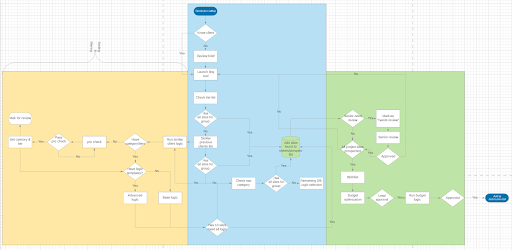19 Oct How to Build Hundreds of Links in a Month (with Less Resources) via @brentcsutoras
Link building is very time-consuming. Just securing 10-20 links a month can be mind-numbing.
But by aligning resources, you can build a program that can help you earn hundreds of links in a month.
On October 14, I moderated a sponsored Search Engine Journal webinar presented by Kevin Rowe, Founder and CEO, PureLinq.
He shared a link building workflow that helped his team generate more than 600 links in 30 days.
Here’s a recap of the presentation.


From zero to 600 links in just a span of 30 days?
It may sound unrealistic, but Rowe’s small team was able to accomplish this feat.
To achieve similar results, you will need a different set of technology and resources than what you have right now.
Also keep in mind that you want to build quality links that are actually going to have a positive impact on your rankings, both short-term and long-term.
In-article, editorial-based links are what typically works for this purpose.
You don’t need to do 10 different types of link building tactics.
Stick to one tactic that is impactful, can have an impact on ranking, and is scalable.
Benchmarks
Before starting your email outreach, it is important to know email marketing benchmarks.
This data from Mailchimp is a good resource that can help you forecast and track campaign metrics.


Rowe’s team used the same Mailchimp data for calculating metrics.
In order to get 600 links based on the general open rates, you’re looking at a prospect list of about 40,000.
You need to build this prospect list intently and this is what’s going to take some time.
Elements of a Link Building Program
Every link building program is composed of different phases and the time it takes to accomplish each component varies.


Some components can be semi-automated.
But if you want to build a robust list and get a high conversion rate, you’ll have to really spend time on the following areas:
- List building
- Identifying sites.
- Vetting for quality.
- Custom emails.
- Targeting by niche/site.
- Sequencing.
- Content.
- Creating an infographic or study.
- Outreach.
- Emailing sites or doing phone calls.
To avoid low reply rates, you also want to make sure that you’re pitching something that fits with the readership of the website you’re targeting.
Of course, you can try coming up with a custom-tailored, one-to-one outreach for a blogger – but this is not realistic.
If you’re going the traditional route, you’ll most likely need 15-48 full-time employees to build 600 links with over 30,000 emails.
Here’s an estimation:


Setting up a Scalable Link Building Program
Rowe came up with a workflow that allowed his team to scale.
First off, narrow your tactic down to one and stick to that.
As much as you can, aim to get rid of the resource-heavy components of the program.
For instance, while leveraging studies and unique research does work, it’s not going to get you to 600 links in one month.
What Rowe did was to narrow down his team’s approach to thematic reclamation and unlinked brand mentions.
They no longer created any on-page content other than what already existed.
The Key Elements of a Scalable Program
You need to get three key elements right to make your link building program scalable:
- Relationships.
- Technology.
- Processes.
Most link builders are familiar with tech and processes. But why focus on relationships?
Building Relationships
Building and maintaining relationships is a crucial part of a scalable link building program.
People are more likely to reply to you if they know who you are and they know that you aren’t just going to spam them every chance you get.
Legitimate relationships with people is really important.
You can leverage PR tools such as Muck Rack to prospect and build relationships with authors, journalists, bloggers, and anybody who is actively contributing to third-party blogs.
Rowe revealed that it took him and his team over two years to build the number of relationships they needed to get to the successful 600 links in one month.
Pitchbox is also another good tool for doing cold outreach and prospecting new sites.
Here’s what the overall process looks like.


This approach entails building your list and maintaining it.
Go through this cycle every month and then after a year, you’ll be able to build a significant list of publishers who are willing to share or link back to your content – as long as you have the value.
Technology: Managing Your Relationships
Another crucial element here is leveraging tools to store and keep track of your relationships.
One platform that can help you with this is BuzzStream which allows users to store a list of all contacts and integrate other metrics or notes you need for your campaign.
This is a major time-saver instead of storing your contacts in a spreadsheet and doing manual tracking.
Once you get past a few thousand relationships, it becomes a little bit harder to manage spreadsheets and
and off-the-shelf tools so you may find that building a custom technology would be better.
Documenting Your Process
Having your processes documented will help get everyone on your team on the same page.
When you document your process, it can serve as a reference point so everyone knows what the steps are for a particular workflow, when the deadlines are, etc.
Here’s a three-step guide from Entrepreneurial Operating Systems on how to document processes.


There are also other process-mapping tools that can make this easier for you.
For example, with Lucidchart, you can build processes clearly and map out different decision points.
A clear process also helps in onboarding new team members – reducing the number of mistakes and improving the quality of their output.
Kevin developed a “mining logic” that allowed his team to do email outreach for several sites per minute as opposed to one site every five minutes.


It identifies the different key areas of the process, when decisions have to be made, and instances when you need senior-level approval.
A good link building program needs a senior-level person to approve and review.
The Email Outreach Process
Assuming you already have the relationships and tools in place, here’s an overview of how to proceed with the email outreach process


1. Identify Criteria
Determine the metrics you’re going to track and what type of pages you want to be building links to.
Also, evaluate what content you have that you want to distribute or get links to.
2. Search Your Database for Sites
For tools, you have the option to filter through the sites according to the niche.
If you’re using a spreadsheet, you’ll have to manually review.
3. Search Ahrefs
Use Ahrefs to identify unlinked brand mention and thematic reclamation opportunities.
4. Pitch Preparation
Create one paragraph and come up with a solid angle and see if you can get that paragraph integrated into your prospect’s article.
5. Outreach
You can leverage BuzzStream or do one-to-one email outreach.
Don’t do bulk pitches across multiple publishers.
You’ll want to go and identify the audience.
And if you’re good at grouping and clustering, you could probably get groups of five to 10 sites together that have the exact same audience to make the pitch.
6. Reconcile
Use ScrapeBox or Moz to “reconcile” the number of links you’ve earned every month.
For Advanced Link Builders: Build Your Own Search Engine
If you want to scale your link building, you might want to think about building your own search engine that crawls and indexes selected sites in your own database.
[Slides] How We Built 600+ Links in 30 Days & You Can, Too
Check out the SlideShare below.
Image Credits
All screenshots taken by author, October 2020
Sorry, the comment form is closed at this time.